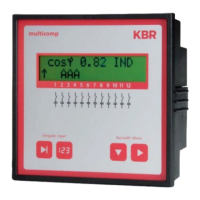Rev. 1.00
20801-EDEBDA0232-4716-1_EN
8
KBR multicomp F144-NC-1V1C6DO6RO-2 Functional principle
1 Functional principle of the controller
The multicomp F144-1V1C6DO6RO-2 hybrid controller has 12 outputs to control capaci-
tive compensation stages. Outputs 1 to 6 are designed to control thyristor modules (by
optocoupler outputs) and outputs 7 to 12 to control capacitor contactors (by oating
relay contacts).
To make optimal use of the thyristor modules' or capacitor contactor modules' switching
performance, you can set the following parameters separately:
for thyristor stages
Switching interval 50 to 9999 milliseconds
Discharge time 20 to 9999 milliseconds
Idle time 20 to 9999 milliseconds
for contactor stages
Switching interval 0 to 10 seconds
Discharge time 0 to 900 seconds
Idle time 0 to 300 seconds
The controller's microprocessor records the mains voltage and current consumption of
the downstream system via measuring transformer inputs (A/D converter) and calculates
the active and reactive power ratio of the power supply. The controller operates in four
quadrants.
• Energy recovery in generator operation is detected and indicated by a “G” ash-
ing on the LCD display. During this time, compensation to CosPhi 1.00 (output
CosPhi) is performed. To prevent alternating switching operations when switch-
ing between recovery and consumption, compensation to the output CosPhi is
performed for 15 minutes when recovery is detected.
The set target CosPhi is not activated until this time has elapsed.
The compensation power required for the target CosPhi is calculated continuously. If
the power di erence corresponds to the set hysteresis (switch on and o hysteresis), the
staged switching is performed in accordance with the compensation power required.
Manually switched stages are, however, not included in the optimization. In case of
identical stages with identical power, the stage that has been switched o for the longest
time is switched on.
Having fewer switching operations results in an optimum adjustment. Even for large
systems, sensitive controls may be set up with only a few modules. Stage ratios do not
have to be considered. After compensation, switching operations are interrupted for
a programmable time. In order to prevent alternating switching operations, the stage

